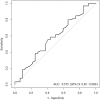Predictive Value of Optic Nerve Sheath Diameter for Diagnosis of Intracranial Hypertension in Children With Severe Brain Injury
- PMID: 35733810
- PMCID: PMC9207325
- DOI: 10.3389/fped.2022.894449
Predictive Value of Optic Nerve Sheath Diameter for Diagnosis of Intracranial Hypertension in Children With Severe Brain Injury
Abstract
Background and aims: Intracranial Hypertension (ICH) is a life-threatening complication of brain injury. The invasive measurement of intracranial pressure (ICP) remains the gold standard to diagnose ICH. Measurement of Optic Nerve Sheath Diameter (ONSD) using ultrasonography is a non-invasive method for detecting ICH. However, data on paediatric brain injury are scarce. The aim of the study was to determine the performance of the initial ONSD measurement to predict ICH occurring in children with severe brain injury and to describe the ONSD values in a control group.
Methods: In this cross-sectional study, ONSD was measured in children aged 2 months-17 years old with invasive ICP monitoring: before placement of ICP probe and within the 60 min after, and then daily during 3 days. ONSD was also measured in a control group.
Results: Ninety-nine patients were included, of whom 97 were analysed, with a median (IQR) age of 8.7 [2.3-13.6] years. The median (IQR) PIM 2 score was 6.6 [4.4-9.7] and the median (IQR) PELOD score was 21 [12-22]. Aetiologies of brain injury were trauma (n = 72), infection (n = 17) and stroke (n = 8). ICH occurred in 65 children. The median (IQR) ONSD was 5.58 mm [5.05-5.85]. ONSD performed poorly when it came to predicting ICH occurrence within the first 24 h (area under the curve, 0.58). There was no significant difference between the ONSD of children who presented with ICH within the first 24 h and the other children, with a median (IQR) of 5.6 mm [5.1-5.9] and 5.4 mm [4.9-5.8], respectively. Infants aged less than 2 years had a median (IQR) ONSD of 4.9 mm [4.5-5.2], significantly different from children aged more than 2 years, whose median ONSD was 5.6 mm [5.2-5.9]. Age, aetiology or ICP levels did not change the results. Thirty-one controls were included, with a median age of 3.7 (1.2-8.8) years. The median (IQR) of their ONSD measurement was 4.5 mm [4.1-4.8], significantly lower than the patient group.
Conclusion: In a paediatric severe brain injury population, ONSD measurement could not predict the 24 h occurrence of ICH. Severity of patients, timing and conditions of measurements may possibly explain these results.
Keywords: brain injury; children; intracranial hypertension; optic nerve; ultrasonography.
Copyright © 2022 Cour-Andlauer, Portefaix, Wroblewski, Rabilloud, Bordet, Cogniat, Didier, Pouyau, Valla, Kassai-Koupai, Siméon, Ginhoux, Courtil-Teyssedre and Javouhey.
Conflict of interest statement
The authors declare that the research was conducted in the absence of any commercial or financial relationships that could be construed as a potential conflict of interest.
Figures






References
LinkOut - more resources
Full Text Sources
Medical

